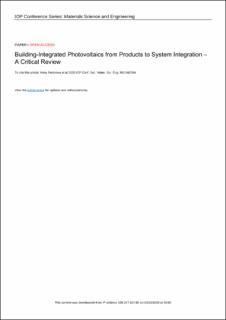Building-Integrated Photovoltaics from Products to System Integration - A Critical Review
Peer reviewed, Journal article
Published version

Permanent lenke
https://hdl.handle.net/11250/2720993Utgivelsesdato
2020Metadata
Vis full innførselSamlinger
- Publikasjoner fra CRIStin - SINTEF AS [5801]
- SINTEF Community [2247]
Originalversjon
IOP Conference Series: Materials Science and Engineering. 2020, 960 1-13. 10.1088/1757-899X/960/4/042054Sammendrag
This review brings together research on the integration aspect of photovoltaic technologies in the building sector. Buildings are among the significant contributors of negative, yet not avoidable, environmental impact. Two primary drivers are pushing the building industry toward sustainability: a goal of lowering the emission levels emitted by the industry, and new norms and regulations on a zero-energy building. The zero-energy building concept is primarily based on the principle that the amount of renewable energy created on the site will be equal to the total amount of energy used by the building during its operational phase throughout its entire lifetime. As a result, the photovoltaic technology was introduced to the building sector, and from there started a rapid research and development of a merged field, building-integrated photovoltaics (BIPV). The market of BIPV is still young and is hence constantly changing. A few BIPV product manufacturers are steadily represented on the market, while new products and manufacturers are emerging and others disappearing now and then. A critical review presented herein provides technical information on existing BIPV products and systems, considering their multi-functionality as a climate screen, energy generator and aesthetic component. Therefore, this paper aims to help to understand BIPV products and systems as well as possibilities and challenges associated with their integration into the built environment of today, thus also giving guidelines for the development and design of BIPV components for the future.
